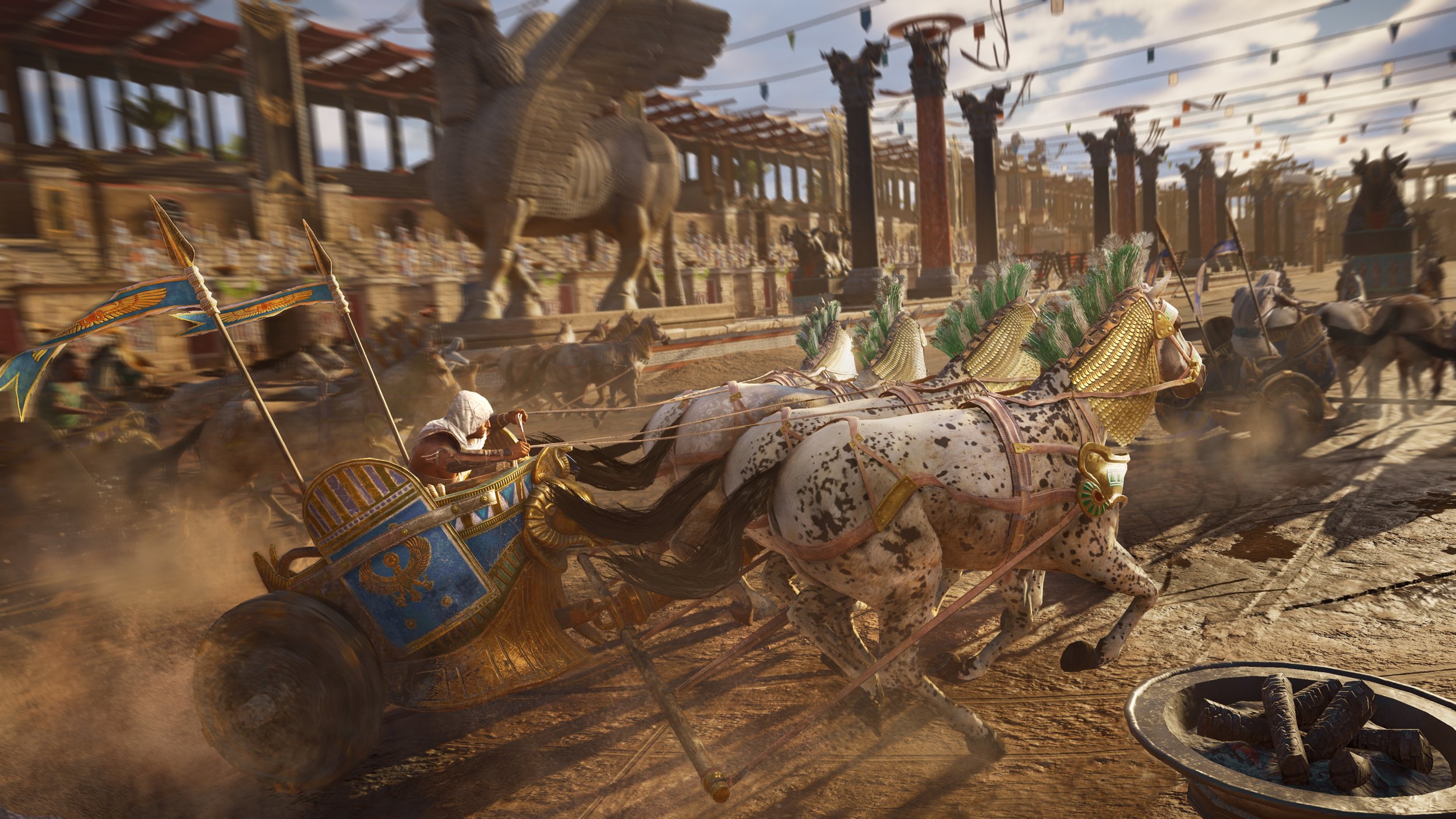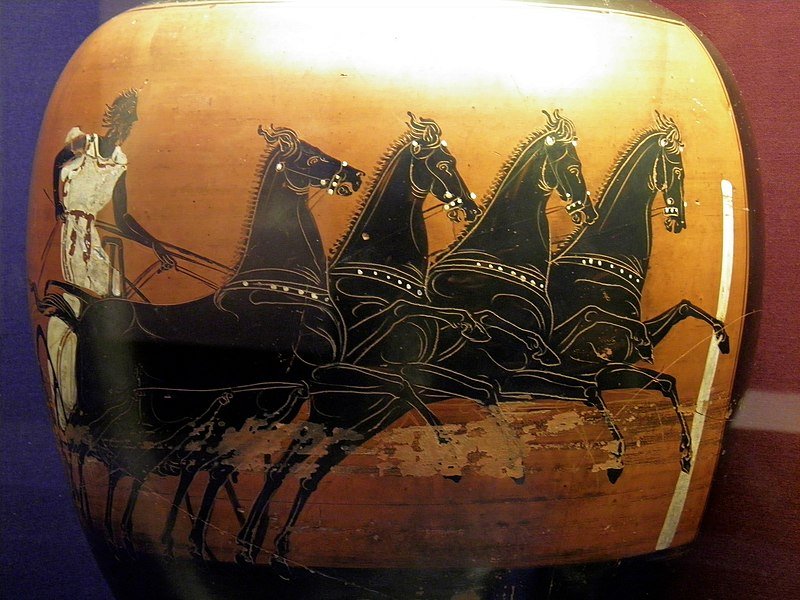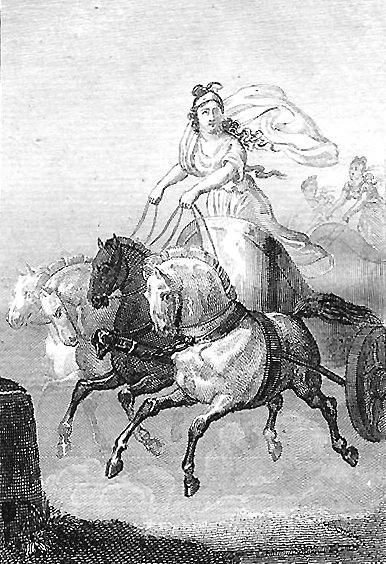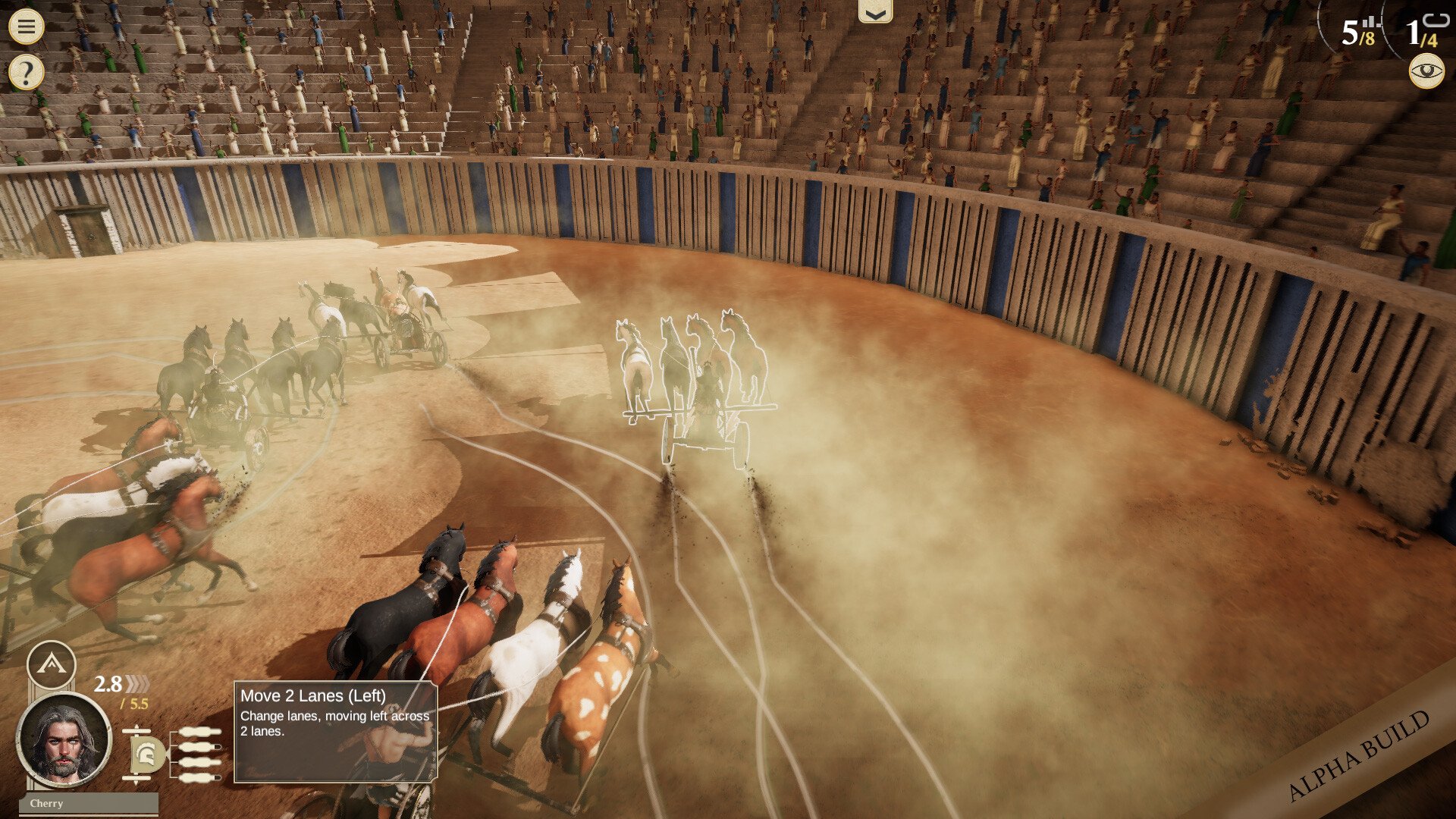Chariot Racing in Games – Horses, Representations and Untapped Potential
Noa Leibson is an art historian, life-long rider and writer of equestrian fiction and non-fiction – and as it happens, someone who plays video games and enjoys discussing them. Noa first reached out to me in late 2020, when Simone de Rochefort’s Polygon article on horse breed history in Assassin’s Creed was shared in the TMQ communities. I finally managed to take her up on her offer to give us all some fascinating insight into ancient historical chariot racing, the men and women (!) who participated in it, and how video games like Assassin’s Creed: Origins succeed and fail in their representations of this fascinating sport.
Noa Leibson and Gatsby in 2018
Noa has a Master’s degree in Art History and Art Conservation with a focus on chariot racing and representations of ancient sport in art. She studied at the Gettysburg College in Pennsylvania, USA and at the University of Glasgow in Scotland. She has written several articles for The Plaid Horse magazine and is working on historical fiction books. Her career in competitive hunters/jumpers and eventing is on hold since her beloved horse Gatsby had to retire due to EPM, a rare nervous disease. As of this year, she’ll be a curator at the International Museum of the Horse in Lexington, Kentucky.
That she’s started applying her knowledge of art history to the historical video games she’s playing will probably not surprise any of my readers – many of us do the same with our equestrian experiences.
“One professor actually showed an image from Assassin’s Creed in class,” Noa tells me. The detailed reproductions of art and architecture featured in Ubisoft’s blockbuster games can provide a valuable overview even for academics. “If you ignore the corpses,” she laughs.
Ancient Chariot Sports and Misconceptions
“Chariot racing was violent, chaotic and gory,” Noa informs me, lending credence to common depictions of the sport in popular culture. “There is evidence of a race with forty participating chariots, where one single man managed to finish the race.”
The tethrippon – the four-horse-chariot – was the most common setup for these events, though three-, two- and one-horse chariots existed as well. Some races were exclusively for mares, others even used mules.
Roman settings dominate common perception of chariot races to the point where artistic renditions of the Greek/Olympic races are hard to find. Image: A Roman Chariot Race by Ulpiano Checa
While many depictions of chariot racing focus on the Circus Maximus in Rome, the sport was immensely popular all throughout the ancient world. “We have archeological evidence of hippodromes everywhere,” Noa explains. Her own main focus is the ancient greek world, though she has also worked with Ancient Rome and explored colonialism in the classical era. Chariot racing rules and characteristics would differ geographically, albeit with significant overlap.
One such regional difference was how many times a chariot had to round the arena to complete the race. “Twelve laps were pretty standard, but some races required up to twenty-three laps,” says Noa.
While the violence of the sport is not a myth, there are other common misconceptions and misrepresentations of chariots in movies and games: “The chariots are sometimes represented as big and ornately decorated,” Noa observes, differentiating between chariots with ceremonial purpose and the ones used in racing. “In reality, the former was light and simple. Not only were they at risk of being ruined, but speed and lightness were crucial factors, much like for modern day racing tack.”
“When you see charioteers wearing armor, that’s also most likely not accurate,” Noa goes on to explain. “Drivers would actually wear a chiton poderos, a long, white, belted garment that would get dirty over the course of the race. For chariot racing, drivers had special belts with loops to thread the reins through, to give the driver more time to grab onto the reins if they were dropped.”
Ancient vase depicting the tethrippon, image source
Ancient vase depicting a goddess abducting a yout in a chariot. Image source
The Charioteer of Delphi, an ancient bronze statue wearing the typical garment of charioteers in the era. Source.
Curiously, the stars of the sport were usually not the charioteers who risked their lives in the arena: praise and victory wreaths would instead go to the owners and trainers of the horses and chariots. This made chariot racing an incredibly expensive sport to get into – both horses and chariots are a significant investment to acquire and maintain – but a perhaps surprisingly diverse one at the same time. Minorities from recently colonized countries could gain respect as charioteers and grooms in ancient Greece. Anyone who could afford a chariot would be allowed to participate in racing.
Assassin’s Creed: Origins
Note: This article discusses games made by Ubisoft, a company that has allegedly harbored and protected known abusers among its high ranking employees for years, and remains slow to make meaningful change in creating a healthier work environment for its more vulnerable workers. More info here, here and here.
Assassin’s Creed: Origins, released in fall 2017, is the tenth mainline entry in Ubisoft’s flagship Assassin’s Creed series and the first to reinvent the action adventure series into a role-playing game direction. While Open World Exploration (on foot or horseback) and Combat are the central gameplay pillars, the blockbuster game features various side activities. One of these is participating in chariot races at the Lageion Hippodrome.
Assassin’s Creed: Origins is set in anicent Egypt around 40 years BC
Chariot Racing in Assassin’s Creed: Origins
“Assassin’s Creed: Origins is not ‘a chariot-racing game’, but it does feature the best implementation of the sport,” says Noa Leibson. “There’s so much effort put into it, for a mostly optional feature.”
The chariot racing in Origins features multiple races and tournaments with high scores to beat and achievements to unlock, rewarding the player with a legendary warhorse mount upon completion.
“In the game, the start and narrow turns are crucial to your performance, that is accurate to real-life chariot racing,” explains our chariot racing expert. “If you mess up the start, it’s very hard to come back from that. This has even more impact in the game than it might have had in the real sport though, because the races in Origins only take three or four laps to complete – significantly shorter than most historical races.”
The number of laps is not the only liberty Origins takes for the sake of gameplay: the arena in the game features all sorts of obstacles on the race tracks, such as fire lines, flamethrowers and scaffolding.
“Having obstacles on the track is very likely not historically accurate,” says Noa. The same applies to ramming other chariots on purpose. “We can assume that nobody was aiming to collide in historical chariot racing. But I don’t mind sacrificing realism for fun where it makes sense.”
Likely not historically accurate: armored horses. Likely historicallly accurate: getting yeeted into the air along with your broken chariot.
Anicent chariot racing was dangerous enough without flamethrowers. Screenshot source.
The sport was plenty dangerous without these additions. Any chariot – of which there were up to forty in some cases, as you may recall – losing a wheel or breaking down on the track would pose an obstacle to other competitors.
“We do have evidence of people hurrying onto the track during and after races to drag injured people to safety,” says Noa, and recalls a scene from Ben-Hur has a scene which represents this.
Another aspect of Origins that gets praise from our expert is the representation of the Hippodrome itself.
“The architecture and the victory monuments in front of the buildings are super good,” Noa explains. “Buildings painted in earthen tones, particularly reds and yellows are also historically well-founded. Olympia in particular was full of victory monuments, with new ones being added after each iteration of the ancient games.”
Noa herself has worked with spectroscopy to research traces of pigment on ancient sculptures and structures during her time in Scotland, examining the Antonine Wall. It’s through methods like these that we now know how much of the ancient world was actually brightly painted, contrary to the common perception of white marble everywhere.
Example of ancient polychromy - brightly colored painting of sculptures and structures, reconstruction. Source
The hippodrome is painted in bright reds and yellows. “Ubisoft did their research,” says Noa Leibson.
Victory monuments were common outside hippodromes and other ancient sporting sites.
Note: The player’s tack does not include stirrups. Those were only invented a few centuries later.
Chariot Horses
And what about the animals used in these contests? Noa Leibson explains that there wasn’t a specific horse breed that was commonly used for chariot racing, “but we know the types of horses common in specific times and areas.”
Assassin’s Creed: Odyssey, Origins’ successor set in ancient Greece, actually represents that type of horse well, Noa informs me. “The horses in Odyssey are perhaps not the most realistic, but they mirror both ancient stylization and modern mediterranean breeds: the horses have relatively short backs and high heads, and they carry themselves quite compactly. They’re fantastic representations of artistic preferences and aesthetics from the time, as seen in depictions like the Parthenon horses.”
Classical horse renditions in relief.
These horses are from the reliefs surrounding the Parthenon on the Acropolis of Athens.
I can’t say I’ve ever been a fan of the AC:O horse models, but Noa makes a solid point for their stylization. Screenshot Source.
A modern Zante horse from Greece Source
This resemblance and inspiration can also be seen in renditions of the now nearly extinct Thessalian horse, as well as more modern examples of Zante and Andravida horses.
“I am mad that they reused these mediterranean horses for Assassin’s Creed: Valhalla though,” Noa adds, explaining that the type of equine at home in the settings of Origins and Odyssey should probably have been replaced with something closer to modern Fjords and Icelandics for the nordic setting in the 2020 Viking game.
Ancient terracotta drinking cup with horses, note the compact build and high head carriage. Source
Bucephalus, the famous steed of Alexander the Great, is said to have been a horse of “best Thessalian strain”. Image Source
For a horse’s placement in the tethrippon, its character was a deciding factor. “The middle horses were your battery, that’s where you’d put the speedy ones,” says Noa. “Whereas the outer two horses are your turn specialists.”
Particularly the horse at the inside edge had to be smart and stay focused in the chaos of a race. “Knowing your horses’ strengths and placing them in specific positions on your team could also be a fun strategic aspect in a management game,” Noa muses.
“We don’t have records for how horses were trained for chariot racing specifically,” says Noa, “but we know about ancient wisdom for training horses for war and riding, and can extrapolate.”
Horses would undergo a careful, time-consuming training regime to ready them for work and war. Noa cites The Art of Horsemanship by ancient greek writer Xenophon as a crucial reference not only for training methods, but for how to pick a good horse for a specific purpose.
“In some ways, it’s fascinating how little has changed since ancient times,” she says.
Kyniska of Sparta and Missed Opportunities
As a fan of the chariot racing in Assassin’s Creed: Origins, but with even more in-depth knowledge of chariot racing in ancient Greece, Noa went into Assassin’s Creed: Odyssey hoping for her favorite sport to make another appearance – and was promptly disappointed, because the opportunity would have been perfect for various reasons.
Kassandra and Alkibiades facing the prospect of sneaking into the Olympics. Image Source
“There is a mission in Odyssey where you have to participate in the Olympic games, because the person who was supposed to do that for you – a character named Testikles – stumbles into water and is eaten by a shark,” Noa tells me. You can watch that scene right here. “Alkibiades, your ally in this mission, is actually recorded to have been a chariot racing champion.”
The player character then participates in the Pankration, practically the ancient greek version of mixed martial arts.
It’s here that ancient Greek gender limitations become relevant: Historically, women – particularly married women – were barred not only from participating in the Olympic games, but from attending the event at all. Entering the festival grounds as a woman was punishable by death.
There was, however, one notable exception: Women were not explicitly banned from chariot racing, because remember, the true victors of the competition were the trainers and owners, which meant that a woman could send a chariot to win a wreath in her name without illegally entering the festival grounds.
Kyniska, early 19th century illustration by Sophie de Renneville Source
This is not a hypothetical situation: A Spartan princess called Kyniska became the first woman to win any of the Olympic games by making use of this exact loophole in 396 BC. She had a monument erected in her honor and entered and won again four years later. “We have to assume that Kyniska didn’t steer her own chariot for the Olympics,” Noa informs me. “But we do know that the Spartan Hyakinthia festival specifically had a chariot race for girls, proving that in some places – including Kyniska’s homeland – women were charioteers.”
Kyniska’s repeated victories had a lasting impact, Noa says: “She was the first woman to win in the Olympic Games, but inspired numerous other women to follow in her footsteps.”
Assassin’s Creed: Odyssey lets players choose between a male or female player character and by and large, tells the same story regardless of who you pick, thereby playing relatively loose with historical gender roles in favor of letting more people in on the power fantasy.
Still, Noa easily convinces me that letting Kassandra or Alexios participate in a chariot race for this mission instead of a hand-to-hand combat discipline would have been a wonderful nod to the fascinating figure of Kyniska of Sparta, and an excellent way to reuse Origins’ chariot racing mechanics.
Chariot Racing Games and Their Potential
Ubisoft isn’t the only studio to ever tackle chariot racing in our medium. Qvadriga is a dedicated chariot racing game from 2014 that convinces Noa in terms of historical accuracy, but not necessarily where gameplay fun is concerned.
Screenshot from Qvadriga, by Turnopia and Slitherine Ltd.
In Qvadriga, the player is a chariot owner. Rather than focusing on the dangerous action, the gameplay is turn-based and strategic. Getting the start right is crucial, and it’s easy to flip over in turns without always understanding why.
I haven’t gotten around to trying the game for myself, so I’m relying on Noa’s impressions here: “It’s pretty educational, but unfortunately not a lot of fun to play.”
The strategic management aspect is something that Noa would absolutely love to see done well in what she imagines as a good chariot racing game though. “Getting a chariot out there was a group effort – picking horses, picking chariots and breeding horses could all be interesting gameplay components,” says Noa. For her, the sport’s unexpected diversity would also be a big selling point in a better ludic representation. “I’d definitely love to see women charioteers, and people from more places than just rome. A well-made chariot racing game could also draw in people from outside the horse-game-niche, I believe.”
Like many of us desperate horse game lovers, Noa might just take matters into her own hands. “I’ve been teaching myself some gamedev stuff, I’d love to make my own chariot racing game one day,” she tells me. A background in 2D art, college computer science classes and some game modding experience helps her in that.
Ancient Arenas: Chariots is being developed and published by Slitherine Ltd.
The game does not have a release date yet, but can be wishlisted on Steam.
In the meantime, Noa eagerly awaits the release of Ancient Arenas: Chariots, a recently announced upcoming title from the same publisher as Qvadriga but with a significantly higher production value. Whether it will hold up in historical chariot accuracy, decent horse animation and overall enjoyability remains to be seen.
And now that I’ve learned more on this topic, I am immediately joining the “We need a good chariot racing game featuring Kyniska of Sparta and women like her” camp, population two. So hey, I know what’s going into my next Horse Games That Should Exist list.

































Moon Channel, a YouTube creator of gaming video essays, has released a fantastic video tackling the history and market of so-called “girl games” – video games deliberately marketed to and targeted at young female players.